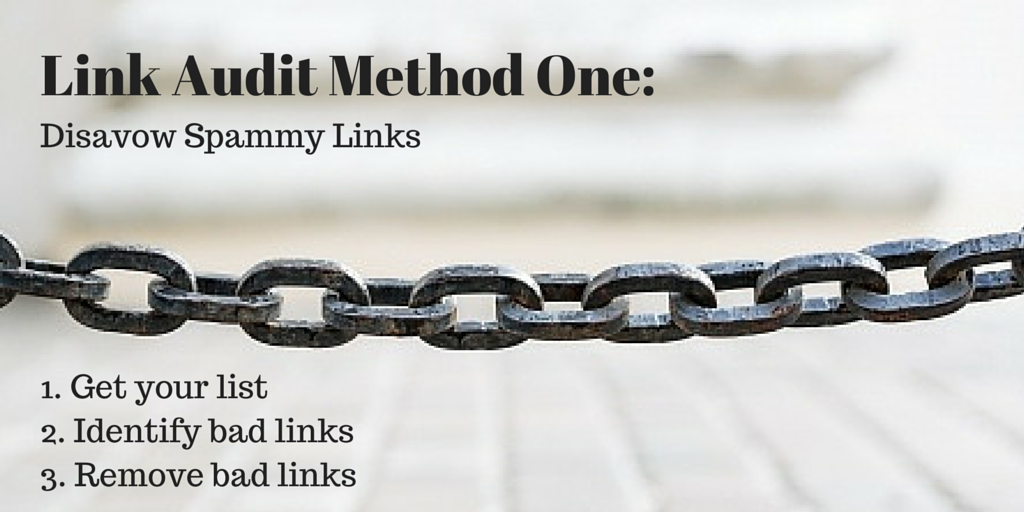
Disavow Spammy Links
In the previous post, we talked about the basic concepts involved in performing in a link audit and the two general categories of risky links:
1.Those that can be checked by visiting the backlink page.
2.Those that are detected only by looking at link patterns.
In this post, we introduce the first method for performing a link audit, which involves only the first category. This method is the easiest for a beginner. It’s limited, but can still be effective.
In this method, you identify toxic links by manually going to each of your backlinks and giving them a visual check. In this way, you can catch all the “on page” risks. Then you take a streamlined approach to resolving the links that you decide are bad.
Remember, this is a “just the basics” method. But we’ll add more complexity as we advance into each method.
Step 1: Get Your Backlink List Collecting Your List
To increase the effectiveness of your link audit, it’s best to collect backlinks from multiple sources.
The first place to go is Google Webmaster Tools (GWT). This free service provides you with a wealth of information, including a list of backlinks.
However, GWT provides only a sampling of your backlinks, so to get a more complete list, it’s necessary to use other link analysis tools such as Majestic SEO, or Ahrefs (these two have the largest indexes). There are many other good tools available including SEO Spy Glass, Bing Site Explorer, Open Site Explorer by Moz, Open Link Profiler, and URL Profiler.
Remember: When it comes to your backlink list, the more, the better. No source is perfect. Each has its own data set (the index of pages they crawl to collect your backlinks) and their own custom software. No data set is complete, and no software program is perfect. So get the most complete backlist you can by using several sources. In this method, we suggest you use at least Majestic or Ahrefs, plus GWT.
Once you’ve collected all these backlinks, combine them into one spreadsheet.
Filtering Your List
Before you are start evaluating your backlinks, make the list as small as possible by filtering out duplicate URLs from your spreadsheet.
There are external tools to help you with this (such as Scrapebox, or the ontolo.com tool), but you can also do it within Excel using the Data/Remove Duplicates feature.
Step 2: Determine which Links Are Bad
 Now that you have a streamlined list, visit each link and make a judgment as to whether it’s a spammy link or not, based on the description of risk issues revealed by visiting the page described in the first post: How to do a Link Audit: Introduction.
Now that you have a streamlined list, visit each link and make a judgment as to whether it’s a spammy link or not, based on the description of risk issues revealed by visiting the page described in the first post: How to do a Link Audit: Introduction.
If you’d like to see some examples of extremely spammy pages, check out Google’s latest examples of the worst spam sites on this page. It includes a “live” spam screenshots – from pages that Google has recently de-indexed.
Once you have some experience in analyzing backlinks, you can tell that some links are spammy just be reading the name of the domain. But if you’re not absolutely sure, check it with your own eyes.
Add new columns to your spreadsheet where you note whether the link is good or bad, and how you want to resolve them (request removal, disavow, etc.). Now simply visit each backlink, catch any that look risky because of on-page factors, mark them as “Bad”, and decide what to do about them.
Step 3: Resolve the Bad Links Links Under Your Control
For links that you have control over, you can either remove them yourself, or change them to a harmless state if you want to keep them. For instance, if you have links from other sites that are legitimate, but “off topic” in terms of what your site is about, you can:
Change them from Follow to NoFollow links.
Change the anchor text to your brand name or a straight URL. (See the first post in this series:: How to Do a Link Audit: Introduction for more details on anchor text.)
But for the majority of your bad links, you’ll need to request removal of the link and/or disavow it.
Removals and Disavows: An Overview Why Removal Should (Usually) Be Tried First
Screaming Frog points out that there are mixed signals coming from Google about the necessity of requesting removals before using the disavow tool.
On the one hand, Google’s disavow page says that the disavow tool should be used with caution, that most sites will not need to use the tool, and you shouldn’t use it unless you are confident that the links are causing issues for you.
One the other hand, in a Google Webmaster video with Matt Cutts, he says it’s fine to use the disavow tool as a pre-emptive measure; if are concerned that you may have links from negative SEO attacks, or if you don’t know where a bunch of suspicious-looking backlinks came from.
So, it’s a situation where you use must your own judgment. In general, we suggest you take the most conservative path if possible. That means requesting removals whenever it’s feasible to do so; documenting your efforts; and then using the disavow tool (if your removal efforts fail).
An Exception to the Rule:
However, sometimes it’s just not feasible to get a backlink removed. If your backlink is in the following categories, we recommend that you disavow them immediately:
◾Obvious Spam Sites: If you have links are coming from scraper sites or other extremely spammy sites, there’s very little chance that your removal request will be answered. So you can save time and effort by going straight to the Disavow process for these links.
◾Link Not Found: This means that an link to you that was previously on an external page is now gone. Since it’s no longer “out there”, some may choose to ignore this link and simply delete it from their list. But, just in case the spam link somehow reappears in the future, it’s safer to use the Google tool to disavow it.
◾Page Offline: This is different from a de-indexed page. If the page is truly offline, you won’t be able to view it even if you type the URL directly into your browser’s address bar. As with the “link not found” item above, it’s best to use the Google tool and disavow this link. (See the Introduction post for more on de-indexed pages.)
How to Request Removal of Spammy Links
The removal process can be a tedious and time-consuming job with a low success rate. Many of your risky links may be from sites that are on auto-pilot or sites whose webmasters just don’t care. The idea here is to accept the nature of the beast, pick a process, and just follow through until it’s done.
There are a few ways to go about finding out who to contact for a removal request:
◾Doing your own research by looking through the site to find a contact form or an email address, or by using Whois.net to find domain owner details.
◾Getting a team to help you. Team up with people within your own company, or hire via Odesk or other freelance job sites.
◾Using tools such as URL Profiler, rmoov, or Remove’em tools to speed up the tasks of identifying contact details and tracking removal requests.
Once you have the necessary contact information, write the person a friendly email requesting the removal of the link(s). It’s a good idea to set up a new email address for all these request emails – so you can keep them separate from your other messages.
Keep track of whether the contacts responded or not, and how many times you sent them removal requests. This data will allow you to document your efforts not only when you submit disavowals, but also when you request re-inclusion if you have received a manual penalty.
How to Create a Disavow File
Google requires you to submit a list of links you want to disavow in the form of a *.txt file.
To prepare this file, include all the “Disavow” links from your spreadsheet, then follow Google’s instructions to make sure you format the file properly. Here are Google’s Disavow instructions, including an example *.txt file.
Once it’s ready, upload your file via the Disavow Tool within Google Webmaster Tools. You can track the progress of your disavowed links from within GWT.
Note: For Bing/Yahoo Search Engine Disavowals, you can find instructions here on How to disavow links in Bing.
Next, we’ll describe a second link audit method using a sophisticated link analysis tool. Stay tuned for Method Two.
Need help with your link audits?
Want to recover from a Google penalty?
At SEO Seattle Consulting, we’re ready to help.
Contact us for a thorough and detailed backlink analysis.

Comments